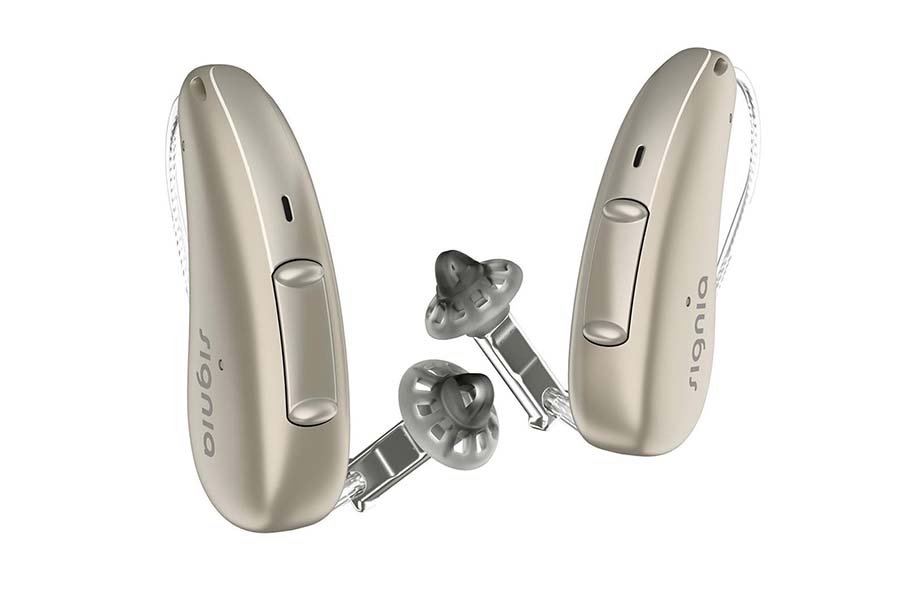We have spoken before here on the pages of Know about the new AX platform from Signia, but in this article, I want to take an in-depth look at the features and what they mean to the user. I was fascinated by their use of two processors to separate and process signal and noise differently. I mean, it is a stellar idea, and more importantly, it seems to work well for many people. While the dual-core system itself is a fascinating move forward, what about everything else? So, in this probably rather lengthy article, I will try to decipher the gobbledygook around the features and explain the benefit in more straightforward language. So let's make a start.

Dynamic Soundscape Processing 2.0
They say, "Dynamic Soundscape Processing takes sound processing to a more precise level by including motion data for a more realistic sound adapted to everyday life."
That translates to an updated version of their original sound management system, which uses input from a motion sensor in the hearing aids to decide if you are moving and change how the aid reacts and focuses on the sounds around you. It will give you a better opportunity to hear your surroundings and a companion if you are in motion.
Augmented Focus™
They say, "Separates the focus sound (speech) from surroundings, creating a clear contrast between the two, which makes it easier to follow conversations."
That translates to; we use the dual cores to separate speech and noise, we process them differently and then present them to you to make the speech signal clearer. It means that when you are in noisier environments, the aids should deliver the speech in a more audible way giving you a better chance to understand what is being said.
Acoustic Sensors
They say, "The redesigned acoustic sensors can detect more variables of sound than ever before, providing more accurate information about the environment."
That translates to they have updated their sound identification systems, which will help them better categorise the sounds in real life to better process them to deliver better hearing to you. A better understanding of the input always means better efficacy on the output, like the garbage in, garbage out rule for databases.
e2e wireless 4.0
They say, "Control coupling, synchronisation, binaural directionality, Spatial Speech Focus, CROS/ BiCROS."
That translates to they have once again updated their connection system between their hearing aids. They use it so the aids can act as a pair, delivering a better experience for you. What is interesting with this one is that they now include binaural compression. That means that they preserve the sound characteristics between the two ears. Sound hits the two ears differently, especially side to side. The updated system preserves that and should give the brain a more natural signal, allowing it to sort it out better. Widex called it Binaural Compression when they introduced it many years ago.
Motion Sensor
They say, "An integrated motion sensor detects whether the wearer is walking, running or sitting still. This motion data complements the acoustic data to optimise Dynamic Soundscape Processing 2.0."
We pretty much covered this already in the Dynamic Soundscape Processing above.
OVP™ (Own Voice Processing)
They say, "Own Voice Processing (OVP™) utilises real-time recognition of the wearer's voice to deliver a natural own-voice impression. Available for RIC/BTE devices with e2e wireless in binaural fittings."
So, first things first, the system is only available when two aids are worn together, and they have to be RICs, or BTEs. The OVP system is impressive; it recognises the user's voice and makes it more natural, reducing auditory occlusion. So why is this important to you, dear prospect user?
To explain, I have to digress a little into the open versus closed fit and occlusion. Open fit more comfortable, closed fit better hearing aids but annoying occlusion. The OVP system means that you can have a more closed fit, better efficacy from your hearing aids and little or no annoying occlusion. Wins all around, really.
Extended dynamic range
They say, "117 dB 24-bit processing for enhanced digital encoding of soft and loud sounds."
That translates to the input of sounds having been increased, which means that the hearing aids can handle loud sounds better. It means the normalisation of louder sound inputs.
SoundSmoothing™
They say, "Reduces the annoyance of sudden loud impact sound such as when handling glassware."
That translates to, SoundSmoothing is an impact noise reduction system; it is used to aggressively attack impact noises to make them more manageable for the user. It will make slamming doors, cutlery in a drawer and the tinkling of glasses much more manageable.
HD Music
They say, "Preset programs for enhanced enjoyment of non-streamed music."
That translates to simply a better preset to handle music; speech is very different from music, and what we need to do for the enjoyment of both is very different. Hence a good Music programme is worth its weight in gold for live music listeners.
eWindScreen
They say, "Reduces the annoyance of wind noise when outdoors."
That translates to a wind noise reduction programme to help reduce wind's effect on the aid's microphones. It makes it easier to hear both sounds and conversation out and about.
Extended bandwidth
They say, "12 kHz bandwidth for enhanced processing of high-frequency speech and environmental sounds."
That translates to the larger the bandwidth, the more normal the sound becomes. Human bandwidth is from 0 to 20kHz during childhood but reduces to around 12 or 14kHz in our twenties. No matter, the higher the bandwidth of the hearing aids, the better the processing of sound around us is.
EchoShield
They say, "Dedicated program for reverberant environments."
That translates to a program designed to deal with sound situations with echo, think of reverberant rooms, lots of hard surfaces. It acts to identify and eliminate the echoes from the sound presented to you. Giving you a better chance to understand what is being said.
Binaural Directionality
They say, "Directionality provides scientifically proven enhanced speech understanding in noise. Available for bilateral fittings with directional microphones and e2e wireless link."
That translates to the aids making decisions on their focus based on communication between the two. Meaning they genuinely act as a pair, delivering the best strategy in the environment for better hearing.
Frequency compression
They say, "Improves the detection of speech sounds for wearers with reduced high-frequency hearing thresholds. Frequency compression is selectively activated based on audiological criteria."
That translates to frequency compression moving sounds that you can't possibly hear because of your loss down into areas where you can still hear. The sound is a little different. However, it means that you get the access to speech sounds that you need.
Spatial SpeechFocus
They say, "Depending on the direction of the dominant speech source, Spatial SpeechFocus steers the directional beam to the left, right, or behind the wearer automatically in a car situation, or in a dedicated "Strolling" program. Available for bilateral fittings with directional microphones and e2e wireless link."
That translates to an intelligent system that will ensure the aids are always focused on the dominant voice no matter where they are in relation to you. The design makes ultra-fast decisions and applies them instantaneously. The motion detector delivers another layer of information to this system to make better decisions about where it is focusing.
Okay, I think I have covered all the important ones. Obviously, this isn't a profound technical explanation. I can give you one if you have insomnia! Funny story about that actually, I once met a chap a long time ago who worked for a hearing aid manufacturer. Brilliant guy, understood the technical details amazingly, put his whole audience to sleep with his delivery; I kid you not.
Anyway, the features mentioned are available in the AX range; some are tech level dependent. Or have slightly different abilities depending on the tech level. If you have any questions, don't be afraid to ask.
Please like us on Facebook by clicking the button below to keep up with our latest utterances. Alternatively, if you don't like Facebook, sign up for the newsletter below. It is important to remember; a hearing aid isn't correctly fitted unless they do Real Ear Measurement.










